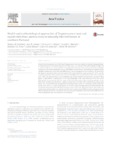Use este identificador para citar ou linkar para este item:
http://www.alice.cnptia.embrapa.br/alice/handle/doc/1052767| Título: | Health and epidemiological approaches of Trypanosoma evansi and equine infectious anemia virus in naturally infected horses at southern Pantanal. |
| Autoria: | PARREIRA, D. R.  JANSEN, A. M.   ABREU, U. G. P. de   MACEDO, G. C.   SILVA, A. R. S.   MAZUR, C.   ANDRADE, G. B.   HERRERA, H. M.   |
| Afiliação: | DANIELA R. PARREIRA, FIOCRUZ; ANA MARIA JANSEN, FIOCRUZ; URBANO GOMES PINTO DE ABREU, CPAP; GABRIEL C. MACEDO, UCDB; ANTÔNIA R. S. SILVA, UFRRJ; CARLOS MAZUR, UFRRJ; GISELE B. ANDRADE, UCDB; HEITOR M. HERRRERA, UCDB. |
| Ano de publicação: | 2016 |
| Referência: | Acta Tropica, v. 163, p. 98-102, nov. 2016. |
| Conteúdo: | Equine infectious anemia virus (EIAV) and Trypanossoma evansi are endemic in Brazilian Pantanal Biome,an important area for livestock production. In this sense, we evaluated the epidemiological single andco-infection effects of T. evansi and EIAV in naturally infected horses in the southern Pantanal wetland byserological tests and hematological assays. Both higher seroprevalence and heath poor condition of thesampled animals were associated with differences in horse management between farms. We found thatthe negative animals for both infectious agents (NN) represented the major group in F1 (37%), and thesmallest group in F2 (19%). Furthermore, we recorded higher EIAV seroprevalence (56%) in F2, comparedto F1 (38%). We observed that T. evansi infection was mostly related to young horses, as seen by theirhigher seroprevalence, ranging from 70.7% in the beginning of the rainy season to 81% in the end offlood period, in comparison with the values of 42% and 68%, respectively, in working animals. on theother hand, working animals showed a higher seroprevalence for EIAV (48%) in both seasons than younghorses. We observed that the management of working horses could be a risk factor of EIAV infection.On the other hand, as T. evansi is maintained in the study region by many species of wild mammals, themechanical transmission through blood-sucking vectors ensures the infection to horses since early. Ourresults showed that single or co-infection by EIAV and T. evansi caused different degree of anemia in theinfected animals. Moreover, the health of horses in Brazilian Pantanal is also influenced by differences inhorse management and environmental circumstances. |
| Thesagro: | Cavalo |
| NAL Thesaurus: | Trypanosoma evansi Horses |
| Palavras-chave: | EIAV Health |
| Tipo do material: | Artigo de periódico |
| Acesso: | openAccess |
| Aparece nas coleções: | Artigo em periódico indexado (CPAP)  |
Arquivos associados a este item:
| Arquivo | Descrição | Tamanho | Formato | |
|---|---|---|---|---|
| coinfecvivaxaie.pdf | 283.35 kB | Adobe PDF |  Visualizar/Abrir |









